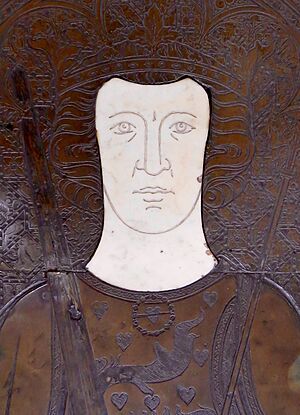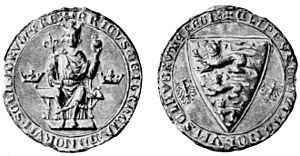Eric VI of Denmark facts for kids
Quick facts for kids Eric VI Menved |
|||||
|---|---|---|---|---|---|

Eric VI on his tomb
|
|||||
| King of Denmark and the Wends | |||||
| Reign | 1286–1319 | ||||
| Coronation | 25 December 1287 | ||||
| Predecessor | Eric V Klipping | ||||
| Successor | Christopher II | ||||
| Regent | Agnes of Brandenburg | ||||
| Born | 1274 | ||||
| Died | 13 November 1319 (aged 44–45) Roskilde |
||||
| Burial | St. Bendt's Church | ||||
| Spouse |
Ingeborg Magnusdotter of Sweden
(m. 1296; died 1319) |
||||
|
|||||
| House | Estridsen | ||||
| Father | Eric V of Denmark | ||||
| Mother | Agnes of Brandenburg | ||||
Eric VI Menved (born 1274 – died 13 November 1319) was the King of Denmark from 1286 to 1319. He was the son of King Eric V and Agnes of Brandenburg. Eric became king in 1286 when he was only 12 years old, after his father died on November 22. Because he was so young, his mother ruled Denmark for him until 1294.
Contents
Early Rule and Challenges
Eric Menved's time as king was a key part of a difficult period in Denmark, from 1241 to 1340. When he first became king, his mother and her German relatives guided him. This time was full of trouble and wars because of his father's death.
One of the first big tasks for the new government was to look into the king's father's death. A court met in Nyborg in 1287. Twenty-seven respected men were chosen to decide the case. Marshal Stig Andersen Hvide and Jacob Nielsen, Count of Halland, along with seven others, were accused. After just one day, the jury said all the accused were guilty. Their lands and money were taken away, and they were sent out of Denmark. If they came back, they could be killed. Even the Pope got involved, saying that those found guilty were no longer part of the church.
Many people questioned if the trial was fair. No one could prove that the accused were right where the king died. Also, the accused were not allowed to promise their innocence in court, which was usually their right. Despite the unclear facts, the jury made a quick decision. The accused had all been close to King Eric V, so it was unclear what they would gain from his death.
Because of these reasons, some historians like Erik Arup and Hugo Yrwing believed the verdict was unfair. They thought the king's death might have been part of a power struggle between two groups of nobles. One group was led by Marshal Stig, and the other by Duke Valdemar. Duke Valdemar had lost power earlier but gained it back quickly after 1288. These historians suggested that Valdemar and his friends might have planned the king's death and then blamed their rivals. Another historian, Kai Hørby, thought the death might have been part of a fight over who should be king. Other people, like the kings of Norway, felt they had a better claim to the Danish throne.
Andersen and the others who were found guilty fled to Norway. King Eirik of Norway welcomed them because he liked to support enemies of the Danish king. He gave Andersen a fortress near the Danish border. Andersen then became a pirate, attacking the Danish coast for many years. The exiles also built forts on islands like Samsø and Hjelm. No ship or coastal town was safe from Stig Andersen Hvide. His biggest attack was in 1289 when he landed with a small Norwegian army. Denmark's regent, Wizlau II of Rügen, used his fleet to push Andersen back to Norway. These events led to forty years of fighting between the Nordic kingdoms.
King Eric's Reign
At the same time, a problem with the church started. The new Archbishop of Lund, Jens Grand, supported the exiles, who were his relatives. This was despite his promise to support the king. Once the Pope approved him, Bishop Jens broke his promise. He even said he didn't care who was King of Denmark as long as it wasn't Eric or his brother. Bishop Jens gave church land to the exiles to build a fort and openly welcomed them.
King Eric could not accept this and ordered Bishop Jens to be arrested in 1294. The archbishop was chained and sent to a dark tower. After some months in bad conditions, the king sent a message to Bishop Jens. He wanted to know if the bishop would promise to be loyal again and not seek revenge. Bishop Jens replied that he would rather be cut into pieces than obey the king. After two years, Bishop Jens escaped with help from a kitchen servant. He went straight to Rome to tell his story to the Pope.
The Pope immediately said the king was no longer part of the church and stopped all church services in Denmark. This would last until Denmark paid Archbishop Jens Grand a huge amount of silver. Denmark could not pay this much money, so the country had no church services for four years. In 1302, King Eric wrote to the Pope, asking for mercy for himself and Denmark. He promised to do whatever the Pope said. Pope Boniface VIII agreed to lower the payment by 80%. The church services started again, and Archbishop Jens was given another job by the Pope, which kept him away from King Eric.
King Eric loved tournaments and spent a lot of money on them. At one knightly tournament in Rostock, drinks flowed for a whole month for anyone who wanted them. The king paid for all the horses and animals, including a huge amount of oats. He created new and unusual taxes to get money from both peasants and nobles. When the taxes weren't enough, the king borrowed a lot of money from German nobles. He even promised parts of Denmark to them as payment.
Eric sent several groups to Germany to try and win new lands. He wanted to make Denmark a strong power in Scandinavia again. He made friends with German princes, like the Duke of Mecklenburg. This helped him become the ruler of some important trading cities. This meant fighting against Brandenburg and other smaller states. He also got involved in Sweden to support his brother-in-law in 1305 and again from 1307 to 1309. At the same time, he was fighting in Germany, hiring German soldiers to help him win.
In 1312, there was a famine in Denmark. When the king still demanded the same taxes, the peasants on Zealand rebelled. Eric stopped the rebellion very harshly, punishing many people severely outside Copenhagen. The very next year, at the Viborg Assembly, peasants and nobles openly rebelled against the king. Eric stopped this rebellion with hired soldiers from Germany, causing damage as far north as Randers. The king then started building many forts. Peasants were forced to work on these forts as punishment for rebelling. Nobles who were involved were sent away or executed, and their property was taken by the king. Four such forts were built: Bygholm, Kalø, Borgvold, and Ulstrup.
In 1313, King Eric gave away all royal land in southern Jutland to the Duke for money. From 1315 to 1317, the crops failed again, leading to another famine. There was nothing left to tax, and the royal treasury was empty. In 1317, Eric promised the entire island of Funen to two German counts for money to pay for 200 knights. Before he died, Eric also promised Skåne to German nobles for more money to continue his lavish spending. As a final blow to Denmark's pride, a German lord captured the Danish fort at Rostock.
When Eric died in 1319, all of his 14 children had already passed away. Denmark was completely broke. His younger brother, Christopher, became King Christopher II and ruled Denmark from 1320 to 1326.
What People Thought of Eric VI
For a long time, Eric VI's rule was seen as one of the few good times during this period. People thought he tried to bring back Denmark's large empire. He has been praised in Danish stories and poems. However, looking back today, his decisions actually started the breakup of the Danish empire in the Baltic and northern Europe. This breakup happened in the next generation.
The king's nickname, "Menved," has been talked about a lot. A popular idea is that it comes from his favorite saying, "by all holy men." Another idea is that it comes from an old Danish word meaning "bird of ill omen," which is a bird that brings bad luck.
Children and Family
King Eric married Ingeborg Magnusdotter of Sweden in June 1296. She was the daughter of King Magnus III of Sweden and the sister of Birger, King of Sweden. They had eight sons who all died as children. They also had six miscarriages. Sources differ on the exact number of children, saying between eight and fourteen. Many of her pregnancies resulted in miscarriages or babies who died very soon after birth.
- Valdemar (died 1302)
- Eric
- Magnus
- An unnamed son (born and died 1318); it is said that Queen Ingeborg was so happy to finally have a live baby. She took the boy out for a carriage ride to show him off. She held him out the window, but she lost her grip, and he fell and died in an accident. Queen Ingeborg then went to live in the Convent of St. Clare in Roskilde, where she died the next year.
There is also some evidence that Eric VI might have had another son, or perhaps a son with Ingeborg later in life, named Erik Sjællandsfar (around 1300–1364). He was buried in Roskilde Cathedral with a crown. However, other ideas suggest he was a son of King Valdemar IV of Denmark.
Images for kids
|
Eric Menved
House of Estridsen
Born: 1274 Died: 13 November 1319 |
||
| Regnal titles | ||
|---|---|---|
| Preceded by Eric V |
King of Denmark Duke of Estonia 1286–1319 |
Succeeded by Christopher II |




